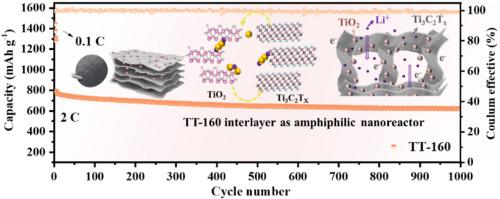当前位置:
X-MOL 学术
›
Mater. Today Phys.
›
论文详情
Our official English website, www.x-mol.net, welcomes your
feedback! (Note: you will need to create a separate account there.)
Building TiO2-Ti3C2Tx heterojunction by microwave-assisted hydrothermal as an amphiphilic nanoreactor for high-performance lithium sulfur batteries
Materials Today Physics ( IF 10.0 ) Pub Date : 2024-10-16 , DOI: 10.1016/j.mtphys.2024.101571 Yu Jiang, Rong Yang, Lei Mao, Guozhuang Gao, Chaojiang Fan, Bailing Jiang, Haochen Liu, Yinglin Yan
Materials Today Physics ( IF 10.0 ) Pub Date : 2024-10-16 , DOI: 10.1016/j.mtphys.2024.101571 Yu Jiang, Rong Yang, Lei Mao, Guozhuang Gao, Chaojiang Fan, Bailing Jiang, Haochen Liu, Yinglin Yan

|
The adoption of lithium-sulfur (Li-S) batteries faces significant obstacles due to the notorious lithium polysulfides (LiPSs) shuttle effect and sluggish electrochemical reaction kinetics. To tackle these issues, MXene, with the unique layered structures and metal centers, have emerged as promising additives in Li-S batteries, effectively hindering the migration of polysulfides through physical and chemical confinement mechanisms. However, MXenes inherently lack robust anchoring sites for LiPSs, leading to suboptimal cycle stability. Here, TiO2 -Ti3 C2 Tx (TT) heterojunction derived from MXene is constructed by the microwave-assisted hydrothermal (MAH). This innovative TT composite incorporates an amphiphilic nanoreactor that synergistically adsorbs, catalyzes LiPSs, and stabilizes the lithium anode in Li-S batteries. The optimally exposed surface of Ti3 C2 Tx and nano-sized TiO2 within the TT architecture collaborate to “conduct, adsorb and transform” LiPSs, while the heterogeneous interface and crumpled sheets provide an efficient three-dimensional transport pathway for Li+ in the electrolyte, collaboratively enhancing the stability of Li-S batteries. Therefore, the TT-160 as an interlayer for Li-S battery exhibits an ultra-low capacity attenuation of each cycle of 0.022 % after 1000 cycles at 2 C. Furthermore, the conductive interlayer facilitates a uniform distribution of Li+ transport, enabling a Li//Li symmetric cell assembled with TT-160 to achieve remarkable stability over 1000 h. This work pioneeringly demonstrates the potential of MXene-derived TiO2 -Ti3 C2 Tx heterojunction, synthesized via MAH for high-performance Li-S batteries, opening up new avenues for material design and optimization.
中文翻译:

微波辅助水热法构建 TiO2-Ti3C2Tx 异质结作为高性能锂硫电池的两亲性纳米反应器
由于臭名昭著的锂多硫化物 (LiPSs) 穿梭效应和缓慢的电化学反应动力学,锂硫 (Li-S) 电池的采用面临重大障碍。为了解决这些问题,MXene 凭借独特的层状结构和金属中心,成为锂硫电池中很有前途的添加剂,通过物理和化学限制机制有效阻止了多硫化物的迁移。然而,MXenes 本身缺乏 LiP 的稳健锚定位点,导致循环稳定性欠佳。在这里,由 MXene 衍生的 TiO2-Ti3C2Tx (TT) 异质结是通过微波辅助水热 (MAH) 构建的。这种创新的 TT 复合材料结合了一个两亲性纳米反应器,可协同吸附、催化 LiPSs 并稳定 Li-S 电池中的锂负极。TT 架构中 Ti3C2Tx 和纳米级 TiO2 的最佳暴露表面协同“传导、吸附和转化”LiP,而异质界面和皱巴巴的片材为电解质中的 Li+ 提供了有效的三维传输途径,共同增强了 Li-S 电池的稳定性。因此,TT-160 作为锂硫电池的中间层,在 2 C 下循环 1000 次后,每次循环的超低容量衰减为 0.022 %。此外,导电夹层有助于 Li+ 传输的均匀分布,使与 TT-160 组装的 Li//Li 对称电池能够在 1000 小时内实现显着的稳定性。这项工作开创性地展示了通过 MAH 合成的 MXene 衍生的 TiO2-Ti3C2Tx 异质结用于高性能锂硫电池的潜力,为材料设计和优化开辟了新的途径。
更新日期:2024-10-16
中文翻译:

微波辅助水热法构建 TiO2-Ti3C2Tx 异质结作为高性能锂硫电池的两亲性纳米反应器
由于臭名昭著的锂多硫化物 (LiPSs) 穿梭效应和缓慢的电化学反应动力学,锂硫 (Li-S) 电池的采用面临重大障碍。为了解决这些问题,MXene 凭借独特的层状结构和金属中心,成为锂硫电池中很有前途的添加剂,通过物理和化学限制机制有效阻止了多硫化物的迁移。然而,MXenes 本身缺乏 LiP 的稳健锚定位点,导致循环稳定性欠佳。在这里,由 MXene 衍生的 TiO2-Ti3C2Tx (TT) 异质结是通过微波辅助水热 (MAH) 构建的。这种创新的 TT 复合材料结合了一个两亲性纳米反应器,可协同吸附、催化 LiPSs 并稳定 Li-S 电池中的锂负极。TT 架构中 Ti3C2Tx 和纳米级 TiO2 的最佳暴露表面协同“传导、吸附和转化”LiP,而异质界面和皱巴巴的片材为电解质中的 Li+ 提供了有效的三维传输途径,共同增强了 Li-S 电池的稳定性。因此,TT-160 作为锂硫电池的中间层,在 2 C 下循环 1000 次后,每次循环的超低容量衰减为 0.022 %。此外,导电夹层有助于 Li+ 传输的均匀分布,使与 TT-160 组装的 Li//Li 对称电池能够在 1000 小时内实现显着的稳定性。这项工作开创性地展示了通过 MAH 合成的 MXene 衍生的 TiO2-Ti3C2Tx 异质结用于高性能锂硫电池的潜力,为材料设计和优化开辟了新的途径。






























 京公网安备 11010802027423号
京公网安备 11010802027423号